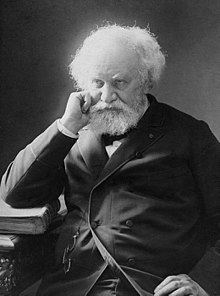Pierre J. C. Janssen
| Pierre Jules César Janssen | |
|---|---|

Jules Janssen c. 1895
|
|
| Born |
February 22, 1824 Paris, France |
| Died | December 23, 1907 (aged 83) Meudon, France |
| Resting place | Père Lachaise Cemetery, Paris |
| Nationality | French |
| Other names | Jules Janssen |
| Known for |
Solar eclipse observations Discovery of helium First director of Meudon Observatory |
| Awards | Legion of Honour |
| Scientific career | |
| Fields | Astronomy, solar physics |
Pierre Jules César Janssen (22 February 1824 – 23 December 1907), also known as Jules Janssen, was a French astronomer who, along with English scientist Joseph Norman Lockyer, is credited with discovering the gaseous nature of the solar chromosphere, and with some justification the element helium.
Janssen was born in Paris into a cultivated family. His father, Antoine César Janssen (born in Paris, 1780 – 1860) was a well known clarinettist from Belgian descent (his father emigrated from Walloon Brabant to Paris). His mother Pauline Marie Le Moyne (1789 – 1871) was a daughter of the architect Paul Guillaume Le Moyne. Pierre Janssen studied mathematics and physics at the faculty of sciences. He taught at the Lycée Charlemagne in 1853, and in the school of architecture 1865 – 1871, but his energies were mainly devoted to various scientific missions entrusted to him. Thus in 1857 he went to Peru in order to determine the magnetic equator; in 1861 – 1862 and 1864, he studied telluric absorption in the solar spectrum in Italy and Switzerland; in 1867 he carried out optical and magnetic experiments at the Azores; he successfully observed both transits of Venus, that of 1874 in Japan, that of 1882 at Oran in Algeria; and he took part in a long series of solar eclipse-expeditions, e.g. to Trani (1867), Guntur (1868), Algiers (1870), Siam (1875), the Caroline Islands (1883), and to Alcosebre in Spain (1905). To see the eclipse of 1870, he escaped from the Siege of Paris in a balloon but the eclipse was obscured by cloud.
In 1868 Janssen discovered how to observe solar prominences without an eclipse. While observing the solar eclipse of 18 August 1868, at Guntur, Madras State (now in Andhra Pradesh), British India, he noticed bright lines in the spectrum of the chromosphere, showing that the chromosphere is gaseous. Present in the spectrum of the Sun, though not immediately noticed or commented upon, was a bright yellow line later measured to have a wavelength of 587.49 nm. This was the first observation of this particular spectral line, and one possible source for it was an element not yet discovered on the earth. From the brightness of the spectral lines, Janssen realized that the chromospheric spectrum could be observed even without an eclipse, and he proceeded to do so.
...
Wikipedia
